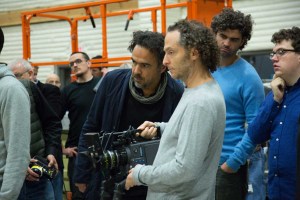
In telling the story of a washed up actor battling his own ego – personified by the iconic superhero, Birdman – director Alejandro Iñárritu wanted to get inside the head of his character in order to explore the creative process. To bring that idea to the screen, the decision to use what looked to be a seamless camera take played a specific emotional purpose for the director.
“The visual grammar became an extension of the state of mind of this character. Basically it put the audience radically into the point of view of this guy. That was what I wanted to achieve. Now, to make it happen, that was another story,” Iñárritu said.
To successfully realize that “continuous” take took a number of steps. The production rented an open space for script reading. Rehearsals included the actors, camera crew and members of the art department. Iñárritu blocked the scenes so everyone could understand the movement and the rhythm, going so far as to measure the length of every step.
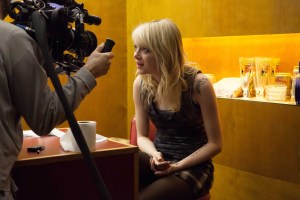 At the same time, the director was defining where the camera should be, and why. He had been friends with Emmanuel Lubezki for about 25 years and although they had never shot a feature together, Iñárritu had shot high-end commercials and a continuous-take short film that screened at Cannes with the cinematographer, so for the director, “This was the perfect opportunity to make this happen, because he is a genius, an artist and an incredible collaborator. He was the obvious choice.”
At the same time, the director was defining where the camera should be, and why. He had been friends with Emmanuel Lubezki for about 25 years and although they had never shot a feature together, Iñárritu had shot high-end commercials and a continuous-take short film that screened at Cannes with the cinematographer, so for the director, “This was the perfect opportunity to make this happen, because he is a genius, an artist and an incredible collaborator. He was the obvious choice.”
Iñárritu and Lubezki used the rehearsals to develop a cinematic language for the film. It was especially important for the shots to work, because they would not have the option of editing out any problems.
“We had to be editing the movement. It took a lot of time for the actors to understand the precision they had to play and for the production department to really start building on those rehearsals,” explained Iñárritu. “Funny enough, this pre-production process was absolutely upside down from everything I have done before because a lot of time and investment had to be in the front.”
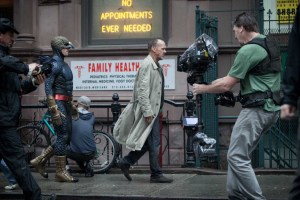 The process of planning the shoot included editors Douglas Crise and Stephen Mirrione. Iñárritu continued, “Nobody could deal with those things later. In this case all those questions and all those editing decisions had to be settled in the beginning before we started shooting. I would say, not only the editors, but the musician, too. For the first time, musicians and editors became part of that process. They became much more active. They were part of the decisions.”
The process of planning the shoot included editors Douglas Crise and Stephen Mirrione. Iñárritu continued, “Nobody could deal with those things later. In this case all those questions and all those editing decisions had to be settled in the beginning before we started shooting. I would say, not only the editors, but the musician, too. For the first time, musicians and editors became part of that process. They became much more active. They were part of the decisions.”
Mexican drummer Antonia Sanchez was one of Iñárritu’s favorite percussionists. “This was the perfect chance to work with a new musician because I only wanted drums,” revealed Iñárritu. A recording studio was rented for a week. Sanchez improvised beats based upon the scene descriptions the director provided. “I used that as a reference for the beat and the speed of the scenes. It was very helpful to have a type of internal metronome for me to find the rhythms.”
The music was recorded in three different stages, at the beginning, in the middle and at the end once the film was complete. Sanchez recorded new cues in Los Angeles. He also finessed older recordings.
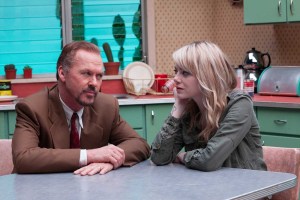 Other than Lubezki, Iñárritu worked with a completely new production crew on this film. Fortunately the director was able to tap into the best craftsmen and artists from New York and Los Angeles. He interviewed a lot of production designers in New York, deciding on Kevin Thompson because “He was so sensitive, had beautiful taste and he completely understood the spirit of New York. As a New Yorker he could bring that to the film.”
Other than Lubezki, Iñárritu worked with a completely new production crew on this film. Fortunately the director was able to tap into the best craftsmen and artists from New York and Los Angeles. He interviewed a lot of production designers in New York, deciding on Kevin Thompson because “He was so sensitive, had beautiful taste and he completely understood the spirit of New York. As a New Yorker he could bring that to the film.”
To get the feel of the theater world and the look he wanted, the director took a lot of pictures inside different theater spaces, which he shared with the production designer. They went together to different theater locations, including during times when plays were actually running, to see the corridors and get a feel for the inner working of the playhouses. “We were allowed to go there and see the whole thing, lighting and all those nuances so we could really feel the spirit of the place,” said Iñárritu.
Iñárritu worked with costume designer Albert Wolsky, who has worked with numerous great directors. “Albert Wolsky is a legend. He is the most amazing, passionate, enthusiastic, no bullshit guy that I have ever met. He does not present the classic Hollywood one hundred possibilities of dressing. He just gives you three and says, ‘What about this, this and this.’ And the three are great. The guy is so knowledgeable of theater and film.”
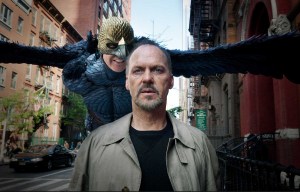 A close relationship developed between the art department and the camera crew, as well as the electric, grip and production sound departments. To make this method of filming successful, sets were designed to shoot 360 degrees. Shots were choreographed so every technical aspect would work. The boom sometimes needed to float on a cord. To keep the shadows of the crew off the character, lights were synced to dim via computer.
A close relationship developed between the art department and the camera crew, as well as the electric, grip and production sound departments. To make this method of filming successful, sets were designed to shoot 360 degrees. Shots were choreographed so every technical aspect would work. The boom sometimes needed to float on a cord. To keep the shadows of the crew off the character, lights were synced to dim via computer.
Corridors posed their own problems. The team knew a door had to be added in a place that looked good, so when Birdman (Michael Keaton) was passing by the door it would be opened at the right time for crew members to duck out of the hall.
“Everything was designed step by step,” said Iñárritu. “People don’t seem to realize how difficult it was. It seems easy, but the whole complication of doing such long takes in such a small place while shooting 360-degrees in every sense – audio, design, lighting, even where to put the cables – we had to meet to decide those things. It was very precise. Everything had to be like a clock.”
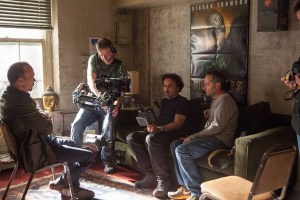 The sequences when the action goes out of the theater through the windows, and the flying sequences with all the action and superhero monsters were the most complicated. These scenes required precise storyboards in order to solve any technical issues within the film’s limited budget. “We had to be really smart. We spent six months dealing with how to solve that,” stated Iñárritu. “That was the most difficult part technically.”
The sequences when the action goes out of the theater through the windows, and the flying sequences with all the action and superhero monsters were the most complicated. These scenes required precise storyboards in order to solve any technical issues within the film’s limited budget. “We had to be really smart. We spent six months dealing with how to solve that,” stated Iñárritu. “That was the most difficult part technically.”
Because the film was shot using a 360-degree space, the sound needed to move with the camera. A long time collaborator and personal friend of the director, sound designer Martín Hernández worked for nine months editing and re-editing the audio. “What the camera does, the audio does,” shared Iñárritu. “The audio has a very strong point of view.”
Re-recording mixer, Jon Taylor, was tasked with panning the sound to match the action in the picture. It took multiple mix sessions to get it right. The director was happy that the nuanced soundscape was noticed by the Academy among the usual action soundtracks full of explosions.
“I am so thankful that the Academy really got the nuances and the subtlety of the mix and the sound design,” noted Iñárritu. “How the sound navigates all the transitions is seamless. You never are distracted going to another atmosphere or set exterior. All that took us so much time. Jon Taylor and Martín did so much amazing work, that I am so glad they are being recognized by an Oscar nomination.”
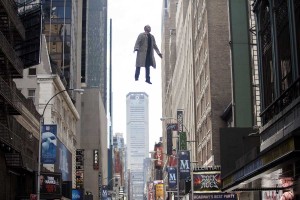 According to Iñárritu, the film was shot three times: first with only stand-ins, then in a rough and raw manner with the actors on the stages early in the construction of the set, which provided a video storyboard for what would be ultimately be the final shoot during production.
According to Iñárritu, the film was shot three times: first with only stand-ins, then in a rough and raw manner with the actors on the stages early in the construction of the set, which provided a video storyboard for what would be ultimately be the final shoot during production.
The shooting schedule was 29 days, a short period for such an ambitious concept. That fact that the production had to get out of the sets or locations without any possibility of returning, added a lot of stress. Their experience allowed the crew to solve problems as they occurred yet despite the many rehearsals in order to sync the rhythm between actors and camera, once the shooting began, the unexpected inevitably happened.
“I can say, no matter how much you rehearse and how much confidence or foundation you have building the scenes, once you are in the real time, the real set, something always fails. That’s the nature of our job. That is why we have to be so good at what we are doing,” explained Iñárritu. “Even if you have rehearsed, when you are playing live and you have a long, long, long shot, you panic. You are freaking out because now is the time or never. Even if you have rehearsed many times, you are never satisfied because you are aiming for the best of the best.”
Because of the way the director chose to explore the inner working of the creative process, the experience on the film became a new and joyous journey of creativity. Iñárritu concluded, “For all of us, the beauty of this film is a process you learn as a kid when you are exploring material. We were not professionals doing what we know, going to the office to do our ordinary job. We were having fun playing, making mistakes, and going back to play again. That is how this film came to be – by a very flexible beautiful spirit of playing with materials, being free, and liberating ourselves from conventional thought. That was beautiful.”





